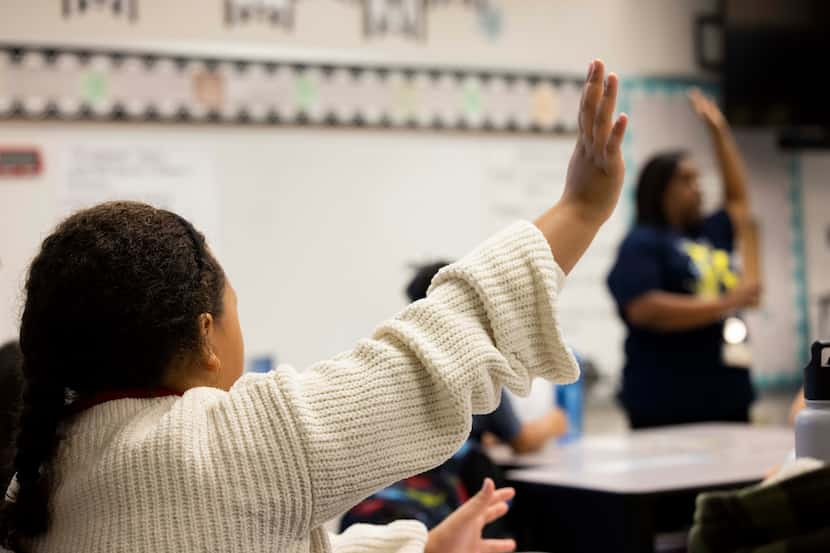Hours after the release of sobering new test scores, Texas’ top education official was clear: Students still have a ways to go to rebound from the pandemic’s devastating impact on learning.
“While we are largely recovering from the effects of the pandemic in reading, much work remains in math,” Texas Education Commissioner Mike Morath said.
Like the rest of the country, Texas students saw declines in math on the National Assessment of Educational Progress. Reading, meanwhile, held more steady though the state long lagged behind others before COVID-19 hit.
The Texas Education Agency – along with local district leaders – highlighted bright spots from the overall gloomy data, including that the state’s ranking relative to other states improved. However, it is still in the bottom half when it comes to reading.
Morath said the results show Texas “recovering from the educational impacts of the pandemic faster than most states.”
While many praised Texas for not losing as much ground as other states, some stressed that “tremendous work” remains.
Robin Lake, director and professor of practice at the Center on Reinventing Public Education, urges Texas educators not to become complacent.
“The goal cannot be to decline slower than other states, or even to catch up,” Lake said. “The goal for recovery must be career and college readiness for every Texas student.”
The results show that students and teachers need resources to address the trauma incurred by the pandemic in addition to academic support, said Zeph Capo, president of the Texas American Federation of Teachers.
“We need schools funded to meet student needs,” Capo said. “We need counselors, social workers, psychologists, and wraparound support for students who are dealing with trauma.”
Capo’s call to action mirrors those from other advocates, including the National Parents Union, which wants states to increase intervention and accountability for chronically underperforming schools; to provide better access to high-quality tutoring; to extend the school day; and to better train teachers.

What can NAEP scores tell families?
Officials say this year’s NAEP scores present the clearest picture yet of the pandemic’s impact on students.
The test – often referred to as the nation’s report card – is given roughly every two years to a representative sample of students in every state, as well as more than two dozen large districts.
Unlike state tests, which vary widely and have changed over the years, the national test has been administered for decades and is the same in every state. It allows for comparisons across states and can be used as an important marker for showing how students are doing over time.
The national results are not broken down by school, so they give families a 10,000-foot view of the state of Texas education. These scores can be used to inform policy decisions that would trickle down to individual students, including potentially more tutoring requirements or teacher training.
How does NAEP differ from STAAR?
Texas students take the annual State of Texas Assessments of Academic Readiness, or STAAR, tests starting in third grade. Federal law requires states to assess students in grades 3-8 and at least once in high school in reading and math annually.
STAAR exams test children in math, reading, writing, science and social studies. Secondary students take end-of-course tests related to such courses.
Unlike NAEP, the STAAR tests measure student performance on state standards. Though the STAAR tests allow for comparisons on how children are performing across the state, they don’t necessarily allow for such comparison between Texas students and those in other states.
Why is there a sharp decline in math?
Math is especially sensitive to what goes on in the classroom, officials say. Previous assessments in Texas and nationally foreshadowed this steep drop in the subject.
Still, it was jarring. The score decline in eighth-grade erased two decades of progress.
That is troubling because the concepts on that test are essential to future STEM careers, said Southern Methodist University professor Candace Walkington.
Texas has used high-dosage tutoring as its main tool for combatting losses triggered by the pandemic disruptions. But Walkington said the solution may not be just throwing more math at struggling students. Schools should work to incite kids’ passion for the subject by connecting it more to the real world, she said.
“We need things that help recapture curiosity and interest,” she said. Students should be taught to “see the usefulness of learning math and relevance of learning math to their lives.”
How did local districts do?
Dallas and Fort Worth largely lagged behind about two dozen urban areas that share district-level data.
In fourth-grade math, 28% of Dallas students scored proficient, while less than a quarter in Fort Worth did so.
Still, in DISD, leaders said they were heartened by reading scores remaining steady (18% proficiency in fourth-grade and roughly 12% in eighth-grade).
“These national results give us a baseline from which we can continue to work to improve and lift up our students,” Superintendent Stephanie Elizalde said in a statement.
Faced with its sharp declines, Fort Worth leaders highlighted that district’s revamped math lessons and a roll out of math-specific academic support.
Why do Black and Hispanic students lag behind peers?
A glaring pain-point from the NAEP data was the wide gaps between how white students performed compared to their Black and Hispanic classmates.
Those communities were especially hard hit by the early waves of the pandemic, which triggered more housing instability and trauma for children. That was on top of pre-existing achievement gaps that experts tie to the lasting impacts of segregation and historic disinvestment in many neighborhoods.
For instance, in 2009, NAEP results showed Black and Hispanic students in Texas were finally scoring where their white peers were scoring in 1992, but racial gaps still persist.
Black and Hispanic fourth-graders scored 24 points lower on average in reading than their white peers in 2022. In math, Hispanic fourth-graders scored 21 points lower than white students this year — with Black students scoring on average 26 points lower on average.
Many districts have made closing racial achievement gaps a priority. Dallas, for example, runs a racial equity office to help with this, and trustees have repeatedly encouraged administrators to funnel time and money toward supporting students of color.
What is Texas doing to catch students up?
The most intensive effort across the state is guided by a 2021 law that requires students who failed STAAR to get intensive tutoring in the subject or be matched with a highly effective teacher.
While tutoring has been shown to make a difference, the state’s effort has been hampered by staffing shortages and other logistics issues.
Meanwhile, Texas requires all early-grade teachers to get training in the science behind how children learn to read and best practices for literacy instruction.
There is not a similarly widespread effort related to math.
(SMU is one of the fiscal sponsors of the Education Lab.)
The DMN Education Lab deepens the coverage and conversation about urgent education issues critical to the future of North Texas.
The DMN Education Lab is a community-funded journalism initiative, with support from The Beck Group, Bobby and Lottye Lyle, Communities Foundation of Texas, The Dallas Foundation, Dallas Regional Chamber, Deedie Rose, Garrett and Cecilia Boone, The Meadows Foundation, The Murrell Foundation, Solutions Journalism Network, Southern Methodist University, Sydney Smith Hicks, Todd A. Williams Family Foundation and the University of Texas at Dallas. The Dallas Morning News retains full editorial control of the Education Lab’s journalism.



/cloudfront-us-east-1.images.arcpublishing.com/dmn/TXWPK6QJXZAUF5LPZKLSHMO42U.jpg)
/cloudfront-us-east-1.images.arcpublishing.com/dmn/MJURAOQXWRCMYMSPJ2GYEZFMBM.jpg)
:no_upscale()/cloudfront-us-east-1.images.arcpublishing.com/dmn/YHB5EU2PY5HZBD3G4HTFRH535Y.jpg)
/cloudfront-us-east-1.images.arcpublishing.com/dmn/QHNQ4MYH6RFKFMOEVCOTE4W6DE.jpg)
/cloudfront-us-east-1.images.arcpublishing.com/dmn/FE2VEAW4KFGXFF3VAGVH3RJOYY.jpg)